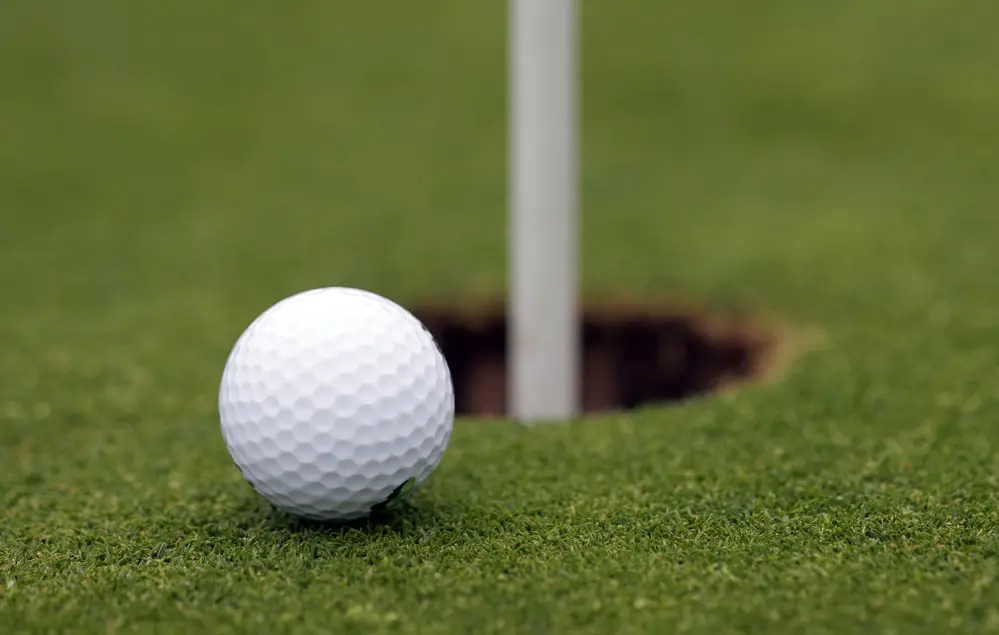Last Updated on November 17, 2023
Golfers have long known that many dimples are on a golf ball, but what they may not know is just how much of an impact those tiny indentations make on the game. It turns out that it’s more than meets the eye. From determining the number of dimples and their depth to understanding why different types of balls react differently when hit off a club face – there’s so much going on with this seemingly simple element. Many dimples are on a golf ball – let’s explore them further in order to unlock their secrets and gain insight into how these little features can change our games for good.
Table of Contents:
- Dimples: The Secret to a Perfect Golf Ball
- How Many Dimples Should a Golf Ball Have?
- Dimple Design
- Dimple Depth Matters
- FAQs in Relation to How Many Dimples are on a Golf Ball
- Conclusion
Dimples: The Secret to a Perfect Golf Ball
The science behind why dimples work is surprisingly simple: they reduce drag. Drag is caused by air resistance as it passes over the surface of an object like a golf ball, slowing it down and reducing its distance. Dimples create turbulence which disrupts this flow of air, reducing drag significantly. This means that when hit with a club, the ball can travel further than if it had no dimples at all.
The secret of the perfect golf ball lies in its dimples – each carefully crafted to help you achieve maximum performance.

How Many Dimples Should a Golf Ball Have?
The number of dimples on a golf ball can vary from one manufacturer to another, but the average is between 300 and 500. The exact number depends on the size of the ball, its weight, and other factors such as aerodynamics.
The main purpose of having so many dimples is to reduce drag when the ball is in flight. When air passes over a smooth surface, it creates turbulence which slows down the speed at which the air moves around it – this reduces lift and causes drag on the object passing through it (in this case, a golf ball). By creating small pockets or ‘dimples’ in the surface of a golf ball, these pockets trap some of that turbulent air which helps reduce drag and increases lift – allowing for greater distances when hit off an iron or driver clubface.
Dimple Design
Different types of dimple designs have been developed over time, each with varying effects on spin rate, lift force and overall distance travelled by the golf ball after being struck with a club head at impact speeds ranging from 100 mph up to 200 mph or more for professional players such as Tiger Woods and Rory McIlroy. The complexity of these dimples has increased dramatically in recent years, leading to improved performance capabilities that can be seen when they are hit at high velocities.

Symmetrical patterns such as hexagonal shapes are often used because they provide consistent performance across all clubs while also reducing side spin, which leads to straighter shots off tee boxes and fairways alike. Other popular designs include octagons (for added control) and circles (for maximum distance). Dimpled patterns can also be customised according to individual preferences; some players prefer larger clusters of shallow indentations, while others opt for smaller groups of deeper ones – both providing unique benefits depending upon their playing style.
Dimple Depth Matters
When it comes to dimple depth, there is no single “right” answer, as different depths can be beneficial for different types of shots. Generally speaking, deeper dimples help reduce drag, while shallower ones provide more lift to keep the ball in the air longer. This means that if you want your shot to go farther, you should opt for deeper dimples; however, if accuracy is your goal, then shallower dimples may be better suited for you.
The shape of each individual dimple also plays an important role in its effectiveness at reducing drag or providing lift. Dimple shapes range from circular to triangular and even hexagonal designs depending on what type of effect you are looking for out of your shot. For example, circular-shaped dimples tend to produce less spin than other shapes, which can result in straighter shots but shorter distances travelled due to reduced lift off the tee box or fairway surface.
On the other hand, triangular-shaped dimples can create more spin, which leads to greater distance but less accuracy as well since it increases sidespin, which affects trajectory negatively unless corrected by adjusting the swing path or stance angle during the setup phase before hitting the shot itself.
FAQs in Relation to How Many Dimples are on a Golf Ball
How many dimples are on a Pro V1 golf ball?
A Pro V1 golf ball is made up of 336 dimples, arranged in a symmetrical pattern. The dimples are designed to reduce drag and increase lift when the ball is hit with a club, resulting in longer and more accurate shots. They also help create spin on the ball for better control over its trajectory. The combination of these features makes the Pro V1 one of the most popular golf balls used by professionals around the world.
What golf ball has 392 dimples?
The golf ball with 392 dimples is the Titleist Pro V1x. It features a spherically tiled tetrahedral dimple design that provides improved aerodynamics and greater distance off the tee. The Pro V1x also has an advanced cover formulation that helps to reduce spin for more control on approach shots while providing a soft feel around the greens. Its combination of performance and durability makes it one of the most popular golf balls among players at all levels.
Why are there 366 dimples on a golf ball?
The number of dimples on a golf ball is determined by the ratio between its circumference and diameter. This ratio is known as the ‘dimple coefficient’, which for most golf balls falls between 300-500. The exact number of dimples varies depending on the manufacturer, but 366 is an optimal amount for creating lift and reducing drag when in flight. It also helps to create more spin, allowing for greater accuracy and control over shots. As such, it has become a popular choice among many professional players.
Which golf ball has the most dimples?
The answer to the question of which golf ball has the most dimples is not an easy one. The number of dimples on a golf ball can vary greatly depending on its manufacturer and type. Generally, however, Tour-level balls have around 400-500 dimples, while recreational-grade balls typically have between 300-400. Some manufacturers even produce speciality balls with up to 1,000 dimples for added spin and control. Ultimately, it’s important to consider what kind of performance you’re looking for when selecting a golf ball, as the number of dimples will affect your game differently.
Conclusion
It’s clear that dimples are a crucial part of the golf ball, and understanding how many dimples are on a golf ball as well as their design and depth, can help players get the most out of their game. Whether you’re an amateur or professional golfer, having knowledge about how many dimples are on a golf ball can give you an edge over your opponents. So don’t forget to take some time to learn more about these tiny but mighty features – after all, it could be the difference between winning and losing.



